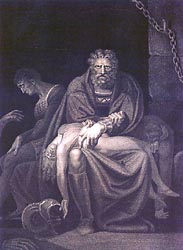 |
| Wikipedia
Count Ugolino Print of Fuseli's lost painting |
Letters, To the Editor of the Monthly Magazine (E 768) SIR,
My indignation was exceedingly moved at reading a criticism in Bell's Weekly Messenger (25th May) on the picture of Count Ugolino, by Mr. Fuseli, in the Royal Academy exhibition
...
"My criticism on this picture is as follows:
Mr. Fuseli's Count Ugolino is the father of sons of feeling
and dignity, who would not sit looking in their parent's face in
the moment of his agony, but would rather retire and die in
secret, while they suffer him to indulge his passionate and
innocent grief, his innocent and venerable madness, and insanity,
and fury, and whatever paltry cold hearted critics cannot,
because they dare not, look upon. Fuseli's Count Ugolino is a
man of wonder and admiration, of resentment against man and
devil, and of humilitation before God; prayer and parental
affection fills the figure from head to foot. The child in his
arms, whether boy or girl signifies not, (but the critic must be
a fool who has not read Dante, and who does not know a boy from a
girl); I say, the child is as beautifully drawn as it is
coloured--in both, inimitable! and the effect of the whole is
truly sublime, on account of that very colouring which our critic
calls black and heavy. The German flute colour, which was used
by the Flemings, (they call it burnt bone), has possessed the eye
of certain connoisseurs, that they cannot see appropriate
colouring, and are blind to the gloom of a real terror."
The theme of Ugolino's imprisonment and suffering was common
among artists. Milton Klonsky writes in Blake's Dante, "As an
instance of papal tyranny, Ugolino's imprisonment and death by
starvation became a popular subject for Protestant English
artists." Blake included images of the family who had been sealed
in a locked tower sentenced to die of starvation in Marriage of Heaven & Hell, in A Small Book of Designs, and
in Gates of Paradise. The caption on the image in Gates
of Paradise is, "Does thy God O Priest take such vengeance
as this?" When Blake illustrated Dante's Divine Comedy near
the end of his life he returned to the tragic incident.
Among the themes Blake alluded to in his images are his opposition to vengeance, the imprisonment of man in his five senses, and the suffering which man brings on himself and his children by violence.
In his final use of the image Blake adds two motifs not present in the earlier images; angels make there presence known in the cell, and the flames of a fire are seen behind Ugolino's head. The protection by the Divine Providence can be seen in the presence of the angels. The cleansing fire of the furnace preliminary to regeneration has been added as well.
 |
| Wikipedia Commons Ugolino in Prison Illustration to Dante's Divine Comedy |

No comments:
Post a Comment